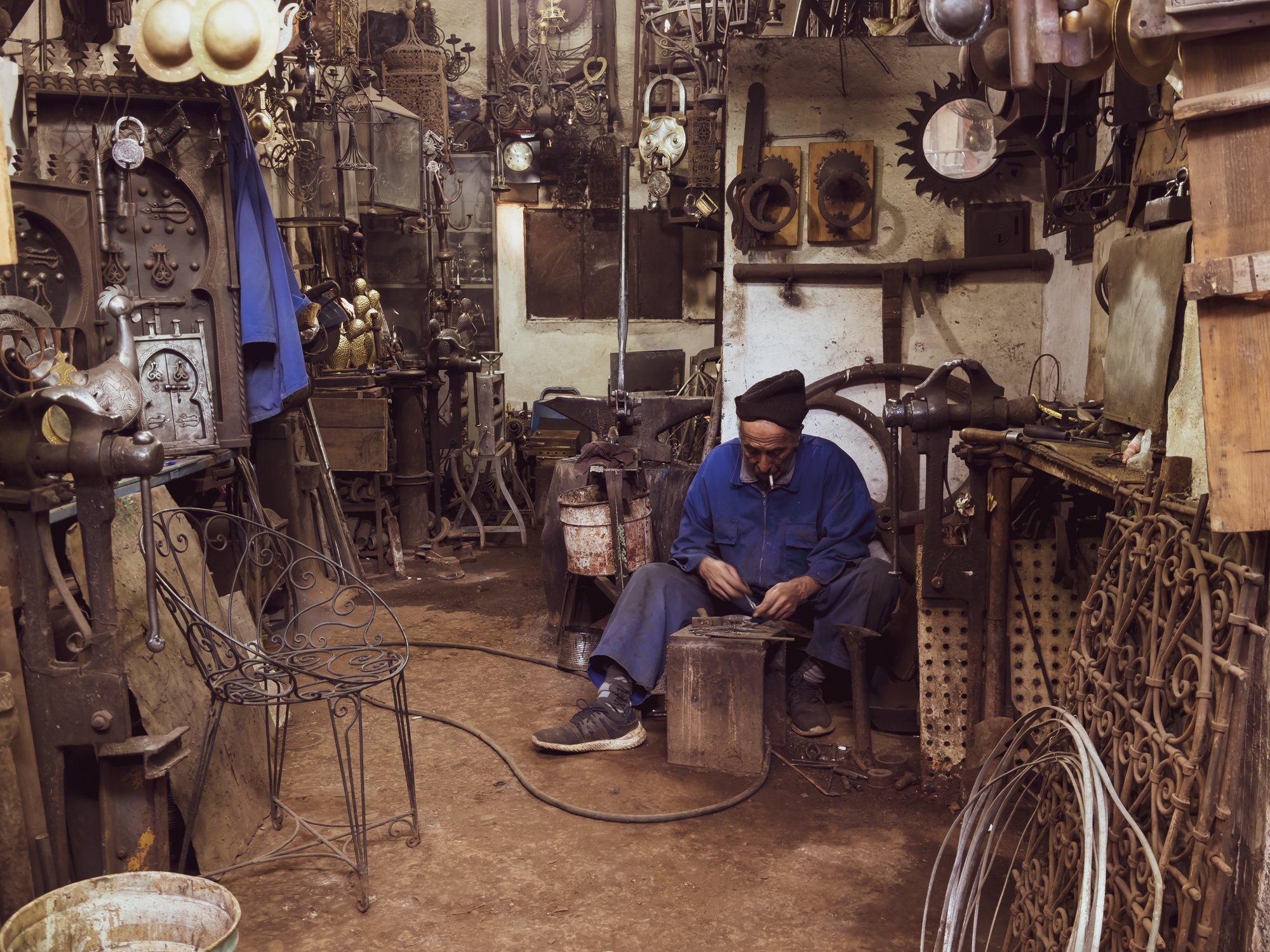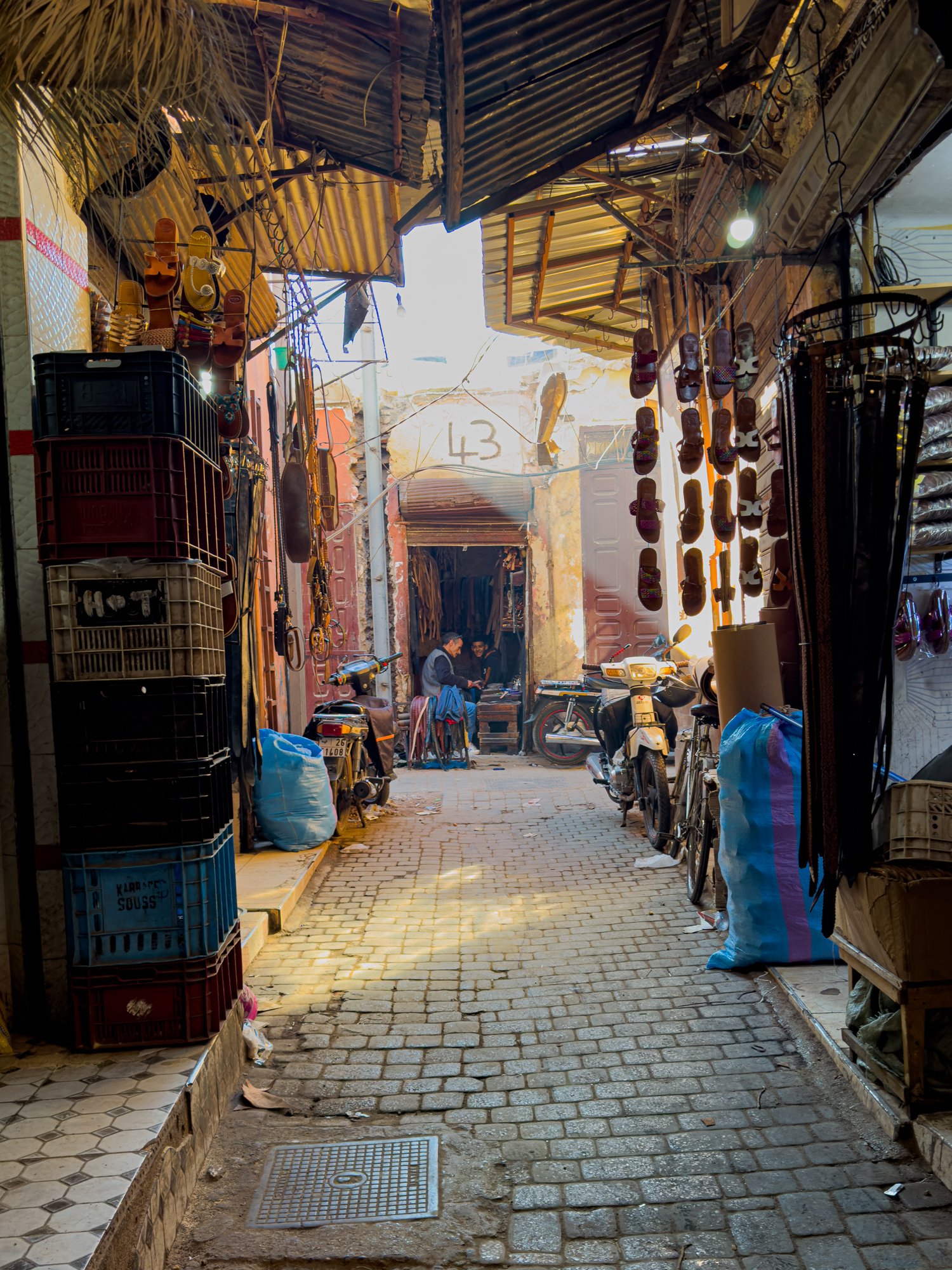On Saturday, we went out with Youssef again, to tour the Medina. This time, Henry had asked him specifically to help him approach people and ask them if they would agree to be photographed. We set out early afternoon, when people were still milling about.
First, Youssef suggested we go to the flea market. It was just outside the Medina, and we would find many interesting people there. They would also be more likely to agree to pose for a quick portrait, for a small amount of money. This is a significant shift to Henry’s approach. He always approaches people directly, and never offers money in return. But it is important to adapt to each place and culture. We will see if this works.
At the flea market, Youssef walks ahead of us and scans the aisles for likely subjects. By now, he has an idea of the type of people Henry is interested in. He spots someone and walks back to us: “What do you think of the man over there?”, he asks. Henry nods. Youssef signals us to hang back. He walks over to him, salutes him politely and asks for a photograph. A quizzical look at us, and then a smile at him, and then he nods in agreement. Youssef signals Henry to come over. I hang back.
The portrait is quick. Henry squats down to get at just the right height, gets the man to look at him, and he takes a few photos. There is no time, and likely no tolerance for shifting position, changing much of the background, no fussing. As long as the person is away from bright sunshine, Henry has to just go for it. He will only know if it is successful once we get back and look at it closely on the computer screen.
We continue like this for a while. Henry spots one man, a carpet seller. Youssef asks him and he is reluctant, he seems shy, perhaps. A younger man comes by and nods encouragingly at him. “Yes! Yes! Why not”!!” He agrees. Two or three frames… and he says something as he laughs. Youssef relates: “He says he wants to go back to Canada with you. He will watch your house and take care of it for you!” The man is laughing with us now.
And we continue like this for the afternoon. Soon, we get back into the Medina through one of the arched doorways. Youssef knows what he is looking for as he scans the place. We go back through the alleys, and Henry gets to make several more portraits. “I will take you to the hammam, in my old neighbourhood. The man there who heats up the oven will be very good to photograph. You’ll see!” Eventually we get there. Inside, Youssef greets his friend, and introduces us to Mohammed.“
I know Henry and I are both thinking the same thing:
There is absolutely no light in here! The place is nearly pitch black!!!
Mohammed is a tall black man in traditional clothing, he is wearing a head scarf - a handsome man for a portrait for sure! If we could only get a few photons of light to throw around in here…
There is a rough area dug about ten feet deep, with the oven on one side. Mohammed sits on the ground and throws straw in the fire. Youssef explains: “He does this from 6 am to 11 pm - seven days a week. Sometimes he has some young boys take over to take a break. He gets fifteen days of vacation in the year, when he can go see his family in the south of Morocco.“ Henry takes a few photographs of Mohammed by the fire. I pull out my iPhone and make a few as well. Then he climbs back up to ground level.
“He will play music for us”, Youssef says. “To make his day easier, whenever he can, he plays his sentir, a traditional Berber instrument that ressembles a guitar, and he sings.“
Henry makes Mohammed’s portrait and I take a few more frames. “Choukran bzaf” - thank you very much - we try to convey our appreciation. Perhaps this was a nice break for him too, to have someone come and listen to him play and sing. At least I hope it was.
Onward we go - a few more portraits. We come to an open square. Henry spots a man and signals Youssef. A quick chat - he agrees. They always seem a bit puzzled. There is no shade here, so I hold my jacket up to shield his face. Henry takes a few frames, thanks him, and gives him a 20 dirham note. Now, the man sitting a few feet away calls out to Youssef. “He wants you to take his photo too too!” I suppose if you get a little something, why not? Right? So a second portrait on this plaza, and then a third…
We wind our way back to the Jamaa el Fna Square. As we walk, I ask Youssef. “I read somewhere that the resistance to being photographed might come because they believe it is forbidden by Islam. Is that correct?”
I know, of course, that there is not a single simple answer. There never is. But Youssef explains a little more. “You see, in Islam, we are forbidden to adorn our walls with any representation of a person. That is why we decorate our walls with such patterns and details. We would never put a portrait on a wall in your home. So the notion of having their photograph taken is difficult for them to understand. And also, they wonder why you would want to have a photograph of them, sometimes even they might wonder what you might want to do with it, be suspicious of it.”
I am beginning to see, even just a little, how it would be strange, invasive, even, for someone to raise their camera and aim it at you, especially in this culture. This has always been a struggle for me, when we travel. I like to make photographs of the people, but I also feel a strong ambivalence.
Henry prefers to do street portraiture. With this style, he always approaches the person first, and asks, whether in a few local phrases he has learned or even just by gesturing to his camera and the person. He always goes fairly close to the person, and asks them to look directly in the camera. The portraits he makes are very powerful and very respectful of the person.
In street photography, the idea is to capture a scene as it happens, without interfering with it - a moment in time. That is what I prefer to do. However, when we travel, I always get a feeling of inequality. We typically travel to countries that are less prosperous than home. As we explore places, I am acutely aware that I am a privileged foreigner, walking around with expensive gear, often worth more than average people would make in a week, a month, even in a year. If I were in their place… how would I feel?
And so, I do make photographs, but I try my best to follow my intuition. If it feels right, I will, but I leave a lot of images behind, doing my best to remember the place, the colours, the textures, the people. I am always aware that I am an outsider, and that as much as I walk through their towns, their streets, try their food, listen to their music, I will never really know what their lives are like. There is always some distance, and that is just how it is.
We get back to the square and Youssef invites us for tea and Moroccan pastries. We sit and chat for a long time, about what life is like here, what it was like during Covid, how traditions are changing and how youths are living in modern ways.
It is already dark when we say good bye. We feel like we know each other better. It’s been another great day in Marrakech.






